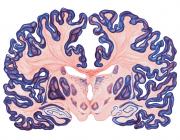
Sabine Kastner

Sabine Kastner
Research Focus
The goal of our research program is to better understand how large-scale networks operate during cognition, with particular emphasis on interactions between cortex and thalamus. We use the visual attention network as a model network. Currently, we are particularly interested in studying the dimension of time. Cognitive function unfolds over time by setting up rhythmically alternating network states. We study these issues in two primate brain models, the human and the macaque monkey, using an integrated and complimentary methods approach of invasive electrophysiology (Electrocorticography in human epilepsy patients [together with Bob Knight, UC Berkeley, and Josef Parvizi, Stanford] and simultaneous multi-site recordings in monkeys) with several brain imaging modalities (functional magnetic resonance imaging, diffusion tensor imaging). Our studies in the two primate brain models are performed in direct comparison using identical behavioral paradigms. In complementary lines of research in the lab, we also study the development of cognitive function in school-aged children.
Profile
Sabine Kastner studies the neural basis of visual perception, attention, and awareness using a translational approach that combines neuroimaging in humans and monkeys, monkey physiology and studies in patients with brain lesions. Dr. Kastner earned an M.D. degree from the Heinrich-Heine University of Duesseldorf (Germany) and received a Ph.D. degree in neurophysiology from the Georg-August University, Goettingen (Germany) under the mentorship of the late Otto Creutzfeldt. After a postdoc at the Max-Planck-Institute for Biophysical Chemistry, Goettingen and an internship in psychiatry, Dr. Kastner joined Leslie Ungerleider’s and Robert Desimone’s lab at the NIMH in Bethesda (1996-2000) before taking on a faculty position at Princeton, where she currently holds the rank of full professor. Dr. Kastner has served as the Scientific Director of Princeton’s neuroimaging facility since 2005. Dr. Kastner has published more than 150 articles in journals and books and has edited the Handbook of Attention (Oxford University Press, 2014). She is a Fellow of the American Psychological Society and her groundbreaking contributions to the field of human cognitive neuroscience were recognized with the Young Investigator Award from the Cognitive Neuroscience Society in 2005. Dr. Kastner serves on several editorial boards and is Editor-in-Chief of Progress in Neurobiology and Frontiers for Young minds/Understanding neuroscience. Dr. Kastner performs public outreach through her educational neuroscience for the 21st century program including teacher seminars, public school outreach, events at PNI, and for parent support groups for neurodevelopmental disability. She was recognized by the Society for Neuroscience’s 2019 Award for Education in Neuroscience.
M.D., UNIVERSITY OF DUSSELDORF, GERMANY, 1993. PH.D., UNIVERSITY OF GOTTINGEN, GERMANY, 1994
- Fiebelkorn IC, Kastner S (2019). A rhythmic theory of attention: sampling versus shifting. Trends in Cog. Neurosci. 23: 87-101.
- Fiebelkorn IC, Pinsk MA, Kastner S (2019). Thalamo-cortical interactions define functional dissociations across the macaque attention. Nature communications 10: 215.
- Arcaro MJ, Pinsk MA, Kastner S (2018). Organizing principles of pulvino-cortical functional coupling in humans. Nature communications 9: 5382.
- Helfrich RF, Fiebelkorn IC, Szczepanski S, Parvizi J, Lin JJ, Knight RT, Kastner S (2018). Neural mechanisms of sustained attention are rhythmic. Neuron 99, 854-865.
- Fiebelkorn IC, Pinsk MA, Kastner S (2018). A dynamic interplay of frontoparietal cortex as a neural basis for rhythmic spatial attention. Neuron 99, 842-853.
- Parvizi J, Kastner S (2018). Promises and limitations of human intracranial electrocorticography. Nature Neuroscience 21, 474-483.
- Halassa MM, Kastner S (2017). Thalamic functions in distributed cognitive control. Nature Neuroscience 20, 1669-1679.
- Kastner S, Chen Q, Jeong SK, Mruczek REB (2017). A brief comparative review on primate posterior parietal cortex: A novel hypothesis on the human toolmaker. Neuropsychologia 105, 123-134.
- Buschman TJ, Kastner S (2015): From behavior to neural dynamics: An integrated theory of attention. Neuron 88: 127-144.
- Arcaro MJ, Pinsk MA, Kastner S (2015): The anatomical and functional organization of the human visual pulvinar. J. Neurosci. 35: 9848-9871.
- Wang L, Mruczek REB, Arcaro MJ, Kastner S (2015): Visual topographic probabilistic maps. Cerebral Cortex 25: 3911-3931.
- Peelen MV, Kastner S (2014): Attention in the real world: Towards understanding its neural basis. TICS 18: 242-250.
- Szczepanski SM, Kastner S (2013): Shifting attentional priorities: Control of spatial attention through hemispheric competition. J. Neurosci. 33: 5411-5421.
- Fiebelkorn IC, Saalmann YB, Kastner S (2013): Sustained spatial selection leads to an interplay of periodic behavioral effects defined by object boundaries. Current Biology 23: 2553-2558.
- Saalmann YB, Pinsk MA, Wang L, Li X, Kastner S (2012): Pulvinar regulates information transmission between cortical areas according to attentional demands. Science 337: 753-756.
- Wang L, Saalmann YB, Pinsk MA, Arcaro MJ, Kastner S (2012): Electrophysiological low-frequency coherence and cross-frequency coupling contributes to BOLD connectivity. Neuron 76, 1010-1020.
- Saalmann Y, Kastner S (2011): Cognitive and perceptual functions of the thalamus. Neuron 71: 209-223.
- Konen CS, Behrmann M, Nishimura M, Kastner S (2011). The functional neuroanatomy of visual agnosia: A case study. Neuron 71: 49-60.
- Peelen MV, Kastner S (2011). A neural basis for naturalistic search in human extrastriate cortex. Proc.Natl. Acad. Sci. 108: 12125-12130.
- Peelen MV, Fei-fei Li, Kastner S (2009). Neural basis of rapid scene categorization. Nature 460: 94-97.
- Beck DM, Kastner S (2005). Stimulus context modulates competition in human extrastriate cortex. Nature Neurosci. 8: 1110-1116.
- Wunderlich K, Schneider KA, Kastner S (2005): Neural correlates of binocular rivalry in the human LGN. Nature Neurosci. 8: 1595 – 1602.
- O’Connor DH, Fukui MM, Pinsk MA, Kastner S (2002). Attention modulates responses in the human lateral geniculate nucleus. Nature Neurosci. 5: 1203-1209.
- Kastner S, Ungerleider LG (2000). Mechanisms of visual attention in the human cortex. Ann. Rev. Neurosci. 23, 315-341.
- Kastner S, Pinsk MA, De Weerd P, Desimone R, Ungerleider LG (1999). Increased activity in human visual cortex during directed attention in the absence of visual stimulation. Neuron 22: 751-761.
- Kastner S, DeWeerd P, Desimone R, Ungerleider LG (1998). Mechanisms of directed attention in ventral extrastriate cortex as revealed by functional MRI. Science 282: 108-111.

